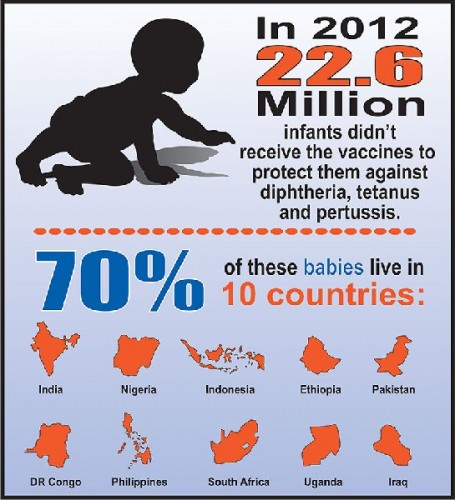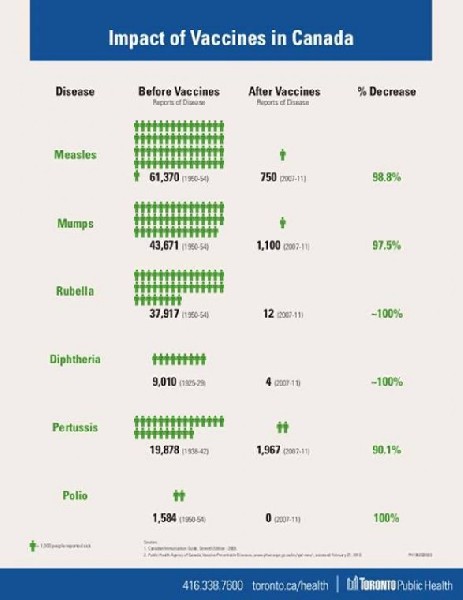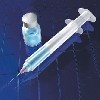The Vaccination Divide
Exploring the Pros and Cons
By: Jimmy Midnight - Aug 25, 2014
When I was a boy a neighbor, who lived just over the back fence, was a little girl who seemed always to be singing happily to herself, songs without words. Today, she would doubtless be diagnosed with Autism Spectrum Disorder (ASD), but back along, oh, say about 1954, she was just characterized as “simple.”
A paper I just read revealed that “Autism” became an available official diagnosis in 1943, which I remembered easily as it is the year of my birth. But like most people, I never heard of it until the late ‘70s or maybe early ‘80s.
This stipulates that fashion in diagnosis is likely the single most important reason for the inexorable rise in the number of ASD cases over the past twenty years. Increased awareness is part of this.
The increase in cases, particularly among little boys, is too large entirely to be attributed to awareness and/or fashion in diagnosis. Am I being too condescending in pointing out that when the prevalence of a disease increases with time, the first question that springs to mind is: What’s different about the environment now as opposed to formerly?
With autism apparently being either a genetic or a childhood-onset condition, the environment as experienced by the very young comes into immediate focus. The recommended battery of vaccinations that our children are now receiving are an unmistakable difference from what was going on two or three decades ago. Vaccines have ended up under a cloud of suspicion as a cause of, or contributor to, ASD.
In the natural sciences, a great many or our experimental protocols are based on single-factor analysis. Pharmaceutical manufacturers can only market single synthetic molecules under patent. Both of these dynamics, as well as the natural human proclivity for simplification, have led to an obsessive drive to ascribe singular etiologies to every disorder. It is not necessarily warranted.
In the ASD case, and also in the case of Gulf War Syndrome (GWS), we may well be looking at multiple diseases with multiple causes. In the Gulf War, our military were in an environment just loaded with toxins like burning oil wells and breathable oxide dust from depleted Uranium munitions.
The concern with anthrax, either because it was feared as a possible biowarfare agent, or just arising from the sick, dying, or dead, animals and people so abundant in war zones, led to inoculation of all our troops with an experimental vaccine, one with a Squalene adjuvant.
Squalene is a naturally-occurring triterpene hydrocarbon. It is found in significant quantities in olive oil, so it’s edible. When injected subcutaneously, it enhances immune responses to the antigens and antigen fragments from target organisms that otherwise wouldn’t foster real immunity. Like many a lipophilic molecule, it also gives rise to its own antibodies, ones which will, in turn, often attack the body’s own lipoproteins. This makes for autoimmune disease.
Will it affect everyone who’s dosed with it? Of course not, in fact Squualene adjuvants, including the serendipitously-named MF59 (MFers!), have been approved for use in some European countries. (And that European regulatory authority is more vigilant, and less corrupt, than our American FDA, seems pretty clear to me.) But I’d be very pleasantly surprised if at least five percent of the American military recipients of that experimental vaccine don’t eventually present with some known autoimmune disease like MS or RA or some mysterious ailment whose autoimmune etiology can’t be so easily pinned-down.
Although the motive for this program was troop safety, it’s a war crime to force an experimental treatment on anyone in a war zone, according to the Geneva Convention.
Which brings us, at last, to the crucial part of this essay—the adjuvant story.
They’ve been part of vaccinations since the very early days. Even back in the 1920s, people noticed that some batches of vaccine conferred far better immunity than others. Of course impurities, the chemist’s notion of dirt, (“I’m a Chemist, and anything I can’t define is dirt.”) were implicated.
Manufacturers soon settled on common alum (“Potassium Aluminum Sulphate” K2Al(SO4)2) as a cheap, reliable, easily-purified Pump-Up-The-Volume agent, for which they coined the friendly-sounding term, “adjuvant.” “Adjunctant” would be a little hard to pronounce, and the sound of it, with all those hard consonants, including the syllable “junk,” is sort of harsh. A harsh term might be more appropriate for a chemical whose action is so poorly understood. So “adjuvant” is a euphemized, bowdlerized term. Maybe a better, clearer, and also non-threatening term would be “enhancer.”
Many of the antigen parts of vaccinations, simply would not confer immunity by themselves. Other ingredients, adjuvants, enhancers, are needed to provoke immune systems into producing the desired antibody. Alum, and Aluminum Hydroxide, and “Amorphous Aluminum Phosphate Sulphate,” and I guess I don’t know what all Aluminum compounds, are used for this, and are the only things so far approved for this purpose by the FDA. They work quite well for this.
They also have real toxicity issues, as did the now, finally, being phased-out Mercurial, Thimerosal. Was it a preservative, or an adjuvant? Don’t fight over this as it’s been touted as either, or both, at various times.
I have to ask in all sincerity: Would you lace your babies’ medicines with a Gringard reagent, and then skin-pop ‘em with it? How much more toxic is a Mercurial than the aforementioned “Magnesials?” The working hypothesis answer would have to be, “Probably a lot.”
Defenders of vaccination, among whom I count myself, have researched the overall safety of the adjuvants Thimerosal, Aluminum salts, and the Squalene formulation MF59. The actual ingredients of MF59 have been allowed to remain a trade secret on behalf of some of these drug-makin’ mammy-pluggers which unsurprisingly gave each in turn a clean bill of hearth. Squalene has been exonerated by a rationale that says, “Well, when we developed a more sensitive detection method, we found anti-Squalene antibodies in untreated people, too.”
It begs the question, “Yeah, but at what kind of titer level? A part in thirty, in sixty, in two-hundred fifty, in a thousand?”
Scientific knowledge about immune systems is extensive. Verily, it is voluminous. But it is not comprehensive. Questions remain. “Why do some ‘lifetime immunities’ supposedly or actually erode over time, requiring, ‘boosters,’ while others do not?” “Do heavy-metal compounds also engender their own antibodies, as many lipophilic substituted Carbons have been shown to do?” “Is there some minimum level of titer (a quantitative measure of antibody availability) below which the problematic autoimmune response in which anti-Sqaulene antibodies consume the nerve-sheath lipoprotein Myelin, cannot occur?” “Could today’s Chemistry methodologies discover a difference between induced and inherent anti-Sqaulene antibodies?” And so on. In my reasonably well-informed personal opinion the phrase, “More sensitive detection method,” speaks volumes.
Another recent study, or should I say, “Exoneration protocol,” apparently manipulated statistics explicitly for the purpose of finding no statistically significant correlation between Aluminum-containing adjuvants and autism, when more generally-accepted methods would have teased that link out of the very same data.
As for the Thimerosal case, it’s being phased-out anyway, so let’s all just Give Thanks. I’ve seen a partisan vaccine defender’s post say of this peculiar compound of Mercury, “They thought it caused autism. It doesn’t.” The natural sciences really have no place for either of these absolute statements. If it caused autism, why didn’t everybody get it? The notion that “It doesn’t” is a negative that, by definition, cannot be proven.
All these mini-rapes of our Queen, our Ideal, Scientific Truthfulness, speak at least of denial, if not corruption. Following the money clarifies how much this is about vaccine sales, and how little about anything else. In these circumstances, outright corruption becomes unnecessary when denial will suffice.
Lately, I’ve been receiving daily e-mails from Dr. Mercola, an optimum nutrition advocate (yeah, and seller of nutritional supplements) who’s probably our most famous anti-vaccine activist. I generally like his stuff because he often comes up with nutritional information that actually is news to me, and I can just read it without viewing a high-pressure sales pitch.
One of his recent posts suggested that, “In nature, disease organisms never enter our bodies except through the mouth-GI tract or respiratory system.” (I paraphrase here, but do not change sense.) This is all about casting aspersions on the whole notion of subcutaneous vaccination injections.
Dr. Mercola, you’re just clearly wrong about this.
Consider for a moment the possibility of insect bites, and the fact that the little buggers do not sterilize themselves prior to treating us like we’d treat a proverbial ham sandwich. Of course, they’re dosing us with a sample of the local micro-flora under skin and probably into muscle; and if there’s blood when you get lucky and slap one of ‘em, it speaks to the penetration of a capillary.
Voila! Subcutaneous, intramuscular, intravenous.
Honestly, Dr. Mercola’s assertion that vaccination is “totally unnatural,” is totally wrong. The delivery method has been around more or less since insects have been flying, long before even our ape-like ancestors walked the Earth. Bites notoriously cause Dengue Fever, Malaria, and numerous other diseases. Self-evidently, they can also engender acquired immunities. Everyday cuts and scrapes also have these potentials.
Let’s think about inoculations as if they were the bites of large insects. Those bites will likely have bacteria, viruses, and traces of whatever’s in the water insects drink and the nests where they are hatched.
Those bites, however, never contain locally massive amounts of any heavy metal ions, or lipophilic molecules. Bites do, however, contain substantial amounts of Formic acid, but as a one-Carbon molecule, it apparently doesn’t create antibodies, or qualify as a “lipophile.” Such molecules are generally understood to contain at least a dozen Carbon atoms.
A word I’ve learned recently that can perhaps shed some light on this situation is “xenobiotic.” When I first saw this, I thought it was ill-chosen terminology because it could, for example, imply phytochemicals produced by foreign plants, and perhaps “extra-biotic” would be a better word choice. But the meaning, that this is about not being part of the biosphere, is clear enough.
It’s also clear enough that a few milligrams of a lipophile or a heavy-metal ion will have some unmistakably powerful effects in the immediate vicinity of the needle-stick. A few milligrams would correspond to hundreds of billions, or single-digit trillions of molecules or ions, delivered into living systems in a way that really is xenobiotic, “totally unnatural” for these sorts of substances. That all kinds of substances can experience differing fates when injected, as opposed to eaten or inhaled, is universally acknowledged. In fact, alum remains on the FDA’s Generally Regarded As Safe list of allowed prepared food ingredients to this day, though it probably shouldn’t. And almost all of it what enters by mouth leaves in our urine.
In bloodstreams, Aluminum toxicity is strongly related to the trivalent nature of Aluminum ions, which apparently have a powerful affinity for enzyme and transport-protein sites that normally bind divalent cations. This is typified by, but not limited to, Calcium. And once in place in these spots, they retain a positive charge, which will likely bind to some sterically-available Glutamate or Aspartate moiety, causing important changes in tertiary structure of the Aluminum-complexed protein. (This sort of thing is now well-documented in the case of the transport protein, Calmodulin.) Presumably, sites that would normally bind to the Mangesiums, and Manganeeses, and divalent Coppers and Irons, and so on, are also subject to this toxicity problem.
Apparently, because of endocrine differences, the brains of little boys are more permeable to many types of substances than those of little girls. This is a possible explanation for the statistically significant rise in autism among this group, all kinds of toxins, including Aluminum ions, being more easily able to gum up these particular “wet works.”
A word which most of us are more familiar with than eighty-five centers like “titer,” “trivalence,” “intramuscular,” “tertiary structure,” and “Aspartate,” is “quackery.” Fewer of us know that the term originated because of the proclivity of health-care professionals of the past to recommend doses of elemental Mercury, “quicksilver,” to their patients. It was given for a variety of conditions, most famously in treating syphilis. Many patients actually recovered, at least temporarily, despite being poisoned. Let’s Give Thanks again, since this practice has disappeared, and the other quicksilver compound, Thimerasol, is on its unlamentable way out.
Because of it trivalence, Aluminum is likely more problematic than Mercury, by which I mean the Mercurial, Thimerosal. Of course, the great majority of recipients of these Aluminum adjuvant-containing immunizations will gain the target immunities without suffering discernible symptoms, much as many of those dosed with quack-silver actually recovered.
Current recommendations are for something like 18 Aluminum adjuvant-containing immunizations by the time our kids graduate from high school, including numerous “boosters,” which knowledge and experience strongly suggest are very likely unnecessary. (In almost all known cases, single immunizations confer lifetime immunity.) So this more or less amounts to latter-day quackery.
“Quack, quack, more quicksilver, more Aluminum, a little is good, and more is quack quack! better!”
That makes for more vaccine sales. For the scientifically-unschooled, the things that health care professionals say, with their abundant dauntingly blockbuster words, are about as understandable as the vocalizations of waterfowl.
On the other hand, it’s possible to prove as a mathematical certainty, that there is such a thing as “herd immunity,” a desirable social good. Dr. Mercola apparently wants everyone to think that optimum nutrition can save all of us, at least as individuals, from any infection, the better to sell nutritional supplements. Optimum nutrition is also a social good, but when infectious agents are sufficiently virulent, they can sicken even those in glowing good health.
A reliance on religious faith as a way of avoiding infection has much less to be said for it. And none of this should be about a cultural divide, as illustrated by a recent measles outbreak that apparently started when a contagious individual from the Philippines went to pray at a Texas church that recommended no vaccinations as a matter of faith. The devastating effects of diseases like smallpox, scarlet fever, and certain epidemic flu strains have now passed out of living memory. My parents’ generation remembered them well, and rather unfondly.
I want to see us as a nation, as a people, verily as a species, obtain herd immunities, but not at the cost of leaving something like one percent of our people with brain disorders. So at this point I’m ready to beg our pharmaceutical manufacturers to please, please, please find a more appropriate adjuvant or adjuvants. Then hopefully reasonably well-informed people can wholeheartedly recommend at least some of these quack, quack, shots.
The problem is that currently-in-use adjuvants have unmistakable possible problems, as a pre-requisite for the reconciliation that would be manifest in a wholehearted endorsement of an immunization schedule—one that included a lot fewer gratuitous “boosters.”
After reading dozens, maybe even hundreds, of relevant articles, posts, and scholarly articles in this field, I have a possible suggestion. Why not try attenuated live vaccines as adjuvants, perhaps even ones scheduled as “boosters?” It’s my understanding that this has already been tried on a limited basis. Maybe this particular idea won’t work, but surely a country that landed on the Moon, now fully forty-five years ago, can come up with an immunization enhancement agent that is both effective and safe.
Until then, I’d like to just close with the following recommendations.
First, if you can read and understand this essay, you can also practice optimum nutrition during pregnancy, eliminating the need for neo-natal Vitamin K shots. I read a post from a young woman who drank a cup of nettle tea daily to make sure, certainly not a bad idea.
You can explain to an obstetrician that you’re confident that your infant is abundantly supplied with all fat-soluble vitamins which famously make their way into developing infants across many a permeability barrier. In view of the molecular structure of Vitamin K, there’s a real concern about its giving rise to lipophilic antibodies, like the highly-similar Squalene is known to do. If an infant or child is in good health, vaccines that are attenuated live are fine to take. Ironically, the Measles, Mumps, Rubella vaccine is one of these. Unnecessary measles cases, anyone?
When we get down to the myriad Aluminum adjuvant containers, people need to make their own calculations around each recommendation, about the prevalence and severity of target diseases and their own level of comfort about Aluminum ions.
The HPV vaccine, with its enhanced proclivity for side effects, and anyway incomplete provision of immunity, at a level where herd immunities are impossible to attain, would be on the contraindicated end of this spectrum. One should, however, never be given an Aluminum shot on the same day as an attenuated live vaccine. That’s amping-up with adjuvant, an already amped-up live attenuated vaccine.
This is a lot of information to have to deal with in bringing up a child. Let me call one more time for a new effective and safe, adjuvant. Please!
While you’re evaluating this information, kindly refrain from conflating concerns about toxicity with climate change denial, or “not believing in” evolution or geology. Amen.
Sidebar on Dr. Andrew Wakefield controversy.



